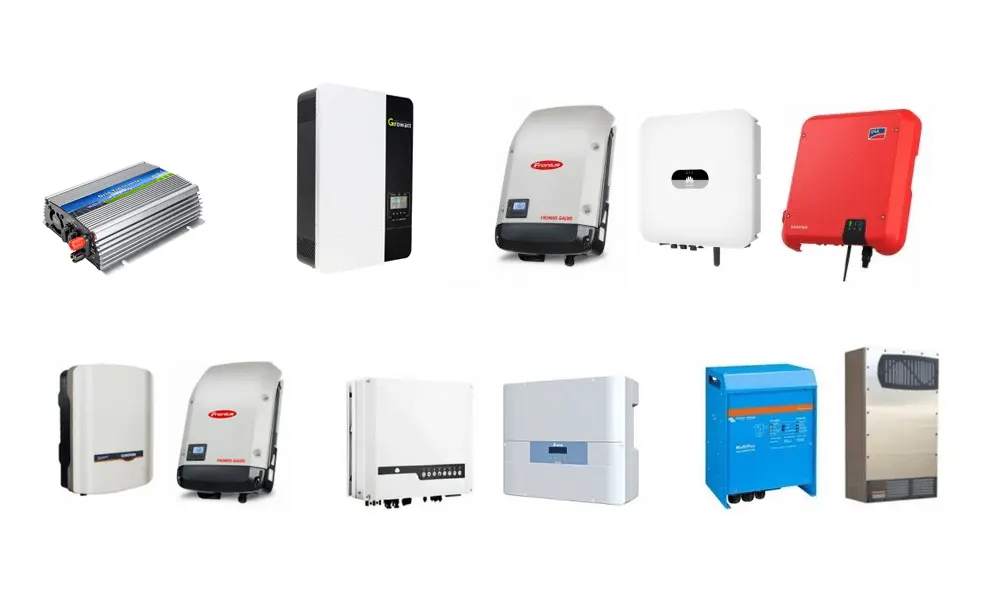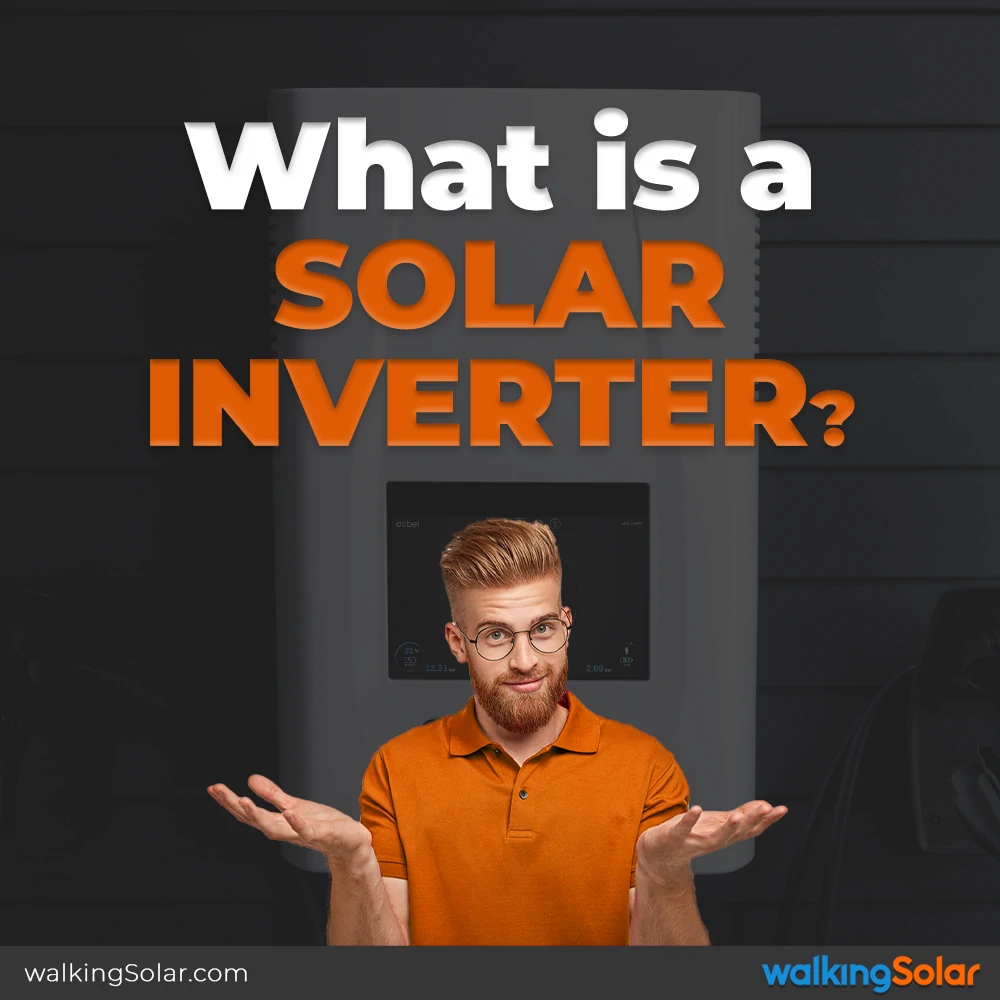A solar inverter looks like a gray or black box, usually with several ports and an LCD screen. It may also have indicators, switches, and other controls. Some solar inverters also have an attached fan or heat sink.

What does a solar inverter do?
While inverting the electrical current, the solar inverter performs several other duties to optimize the functionality of the solar panel and guarantee a safer system. What are the functionalities of a solar inverter?
- Invert the direct current to the alternating current
As we said earlier, the prominent role of a solar inverter is to invert the energy from the solar panel to an alternating current which can be used in most electrical devices.
- Optimize the power output
Solar inverters use maximum power point tracking to maximize the power output. Maximum power point tracking is a technique that is deployed to optimize energy extraction in different configurations. It samples the output from the solar cells, calculates the resistance, and obtains the maximum expected power at any given time.
- Provide a Grid interface
Apart from that, some modern inverters provide a one-way or two-way communication interface between the inverter and the grid. As a result, solar inverters help the grid carry out its functionalities by providing a favorable environment.
For instance, it can turn to standby mode, listen to any change, detect a disturbance, and switch it off if it persists. Consequently, it helps the grid function through minimal disruptions.
- Track the output of the solar system
The latest inverters in the market can be connected to WI-FI, Bluetooth, or Ethernet. Thus they provide a communication interface to view error codes or other important information from the solar panel.
- Provide safe system operation
Lastly, the solar inverters are crafted to provide a safe system by detecting any electric arcs and turning off the system. Thus, they remove any potential electric risks.
How does a solar inverter work?
We have made it clear what a solar inverter does. It converts the direct current from the solar panel to alternating current, which can power devices. But how does it achieve all that? Let’s dig deeper into how it operates.
Let’s start with where it all originates; solar cells, also known as photovoltaic cells, receive solar energy from the sun and convert it into electric power. However, electrical power cannot be supplied to most of the standard electrical devices.
Thus, it is passed to a solar inverter that inverts the electrical energy to output compatible with standard electrical devices. The inverter receives the direct current and passes it through two or more transistors.
A transistor is a semiconductor electrical device used to switch electrical signals from one type to another. In our case, it switches the signals from the direct current signal to the alternating current signal.
These transistors feed the current to a transformer through two varying sides, which changes the motions of the current from direct motion to fourth back motion. At this point, it outputs alternating current, which can be used on standard electric equipment.
What are the various types of solar inverters?
- String inverters
These types of solar systems have their inverters arranged in a string-like manner. Each inverter forming the strings has its supply of DC, which it alters to ac. This setup is standard in installations where the panels do not face different directions.
- Central inverters
Central inverters were inverted to increase the capacity of string inverters. In this case, the strings do not run openly, but rather, they are arranged in a combiner box such that the dc must pass through a central inverter before it is converted to ac.
These inverters’ outputs range from MWs to KWs. Due to this high output, they are pretty common in large commercial setups.
- Micro-inverter
Next, we have micro-inverters, which are used for both residential and commercial purposes. Unlike the string and central inverters, they have module-based electronics which invert the current instead of the string-like setup.
- Hybrid inverter
Hybrid inverters are battery-powered inverters. It incorporates a DC coupling technique to give a battery interface and electronics that manage the discharging and recharging of the battery. Their main advantage is that they provide continuous operations, which are needed for critical loads.
Below is a table showing the power range of the inverters, their efficiency, their popularity in the market, and remarks
| Type | Power | Efficiency | Market Share | Remarks |
| String inverter | up to 150 kW) | 98% | 61.6% | Cost €0.05-0.17 per watt-peak. Easy to replace. |
| Central inverter | above 80 kWp | 98.5% | 36.7% | €0.04 per watt-peak. High reliability. Often sold along with a service contract. |
| Micro-inverter | module power range | 90%–97% | 1.7% | €0.29 per watt-peak. Ease-of-replacement concerns. |
Source:
Fraunhofer Institute for Solar Energy Systems ISE
What is the difference between a solar inverter and a normal inverter?
Even before I get any deeper, let me clear out this hoax in most people. Normal inverters cannot be used in place of a solar inverter. Yes, I know that they both convert direct current to alternating current. However, a solar inverter crafting is optimized to give more functionalities than simply inverting the current.
With that said, what are the differences between a solar inverter and a regular inverter?
A normal inverter, also known as a power inverter, is a basic inverter that takes power from batteries and uses transformers and switches to invert dc to ac.
On the other hand, a solar inverter is a type of inverter that can do more than just invert the current. It has different techniques that can detect disturbances or even support Bluetooth connections to offer a communication interface.
Additionally, solar inverters can identify electrical arcs and perform the necessary preventive mechanism, which is not possible with normal inverters. In short, normal inverters are different from solar inverters, and they cannot be used in place of solar inverters.

Does a solar inverter require a battery?
Solar systems with battery-powered inverters will require a battery to operate. However, hybrid inverters have been invented and are optimized to work with or without the battery. Consequently, if your inverter requires a battery to function, you need to look for a high-quality item.
While looking for a battery for a solar inverter, you should significantly consider the capacity. Its capacity quantifies the amount of power it can store in kilowatts. Ideally, 25 kilo watts are recommended for households.
Apart from that, you should also consider the depth of discharge. The depth of discharge determines the amount of power the panel can supply before depleting its lifespan.

Eng. Matthew Joseph Nandirio is the Founder of walkingsolar.
After graduating from the University of Houston in 2002, matt started working as a Solar Electrical Engineer for several multi-national solar energy companies.
He has a wide range of experiences including solar system requirement analysis, planning, maintaining, debugging and even solar device development through research.
He now shares his 20 years of expertise through his articles on the walkingsolar website.
Further, he is also the author of two books on Solar Technology, “Solar Power for Villages” and “DIY Solar System for Dummies”.

